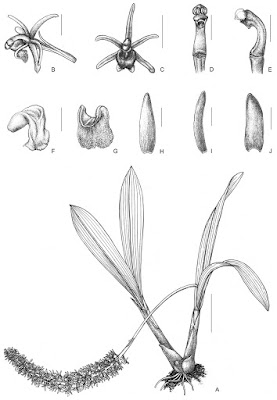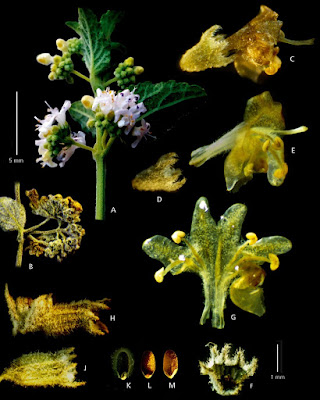[Most Recent Entries] [Calendar View]
Monday, March 18th, 2019
| Time | Event | ||||||
| 1:55a | [Botany • 2019] Liparis napoensis (Orchidaceae) • A New Species from Guangxi, China
Abstract Liparis napoensis, a new orchid species belonging to section Cestichis from Guangxi, China is described and illustrated. It occurs in the karst limestone forest. The new species is morphologically similar to L. viridiflora and L. somae, but can be readily distinguished by having narrowly oblong-falcate petals; flabellate-quadrate lip distinctly concave at base and emarginate at apex; conspicuously arcuate column with a pair of wedge-shaped wings. Keywords: Malaxideae, Napo County, orchid, section Cestichis, taxonomy Liparis napoensis L.Li, H.F.Yan & S.J.Li, sp. nov. Diagnosis: Liparis napoensis differs from its closest allies: L. viridiflora and L. somae in the clustered ovoid-cylindrical or narrowly pyriform pseudobulbs, narrowly oblong-falcate petals; a flabellate-quadrate lip with a distinctly concave base, an emarginate apex and erose margins; a conspicuously arcuate column with a pair of wedge-shaped wings. ... Distribution and habitat: Endemic to Guangxi in China. Lithophytes in rocks crevices where soil or organic matter has accumulated at elevations from ca. 650 m to 900 m in karst limestone forest. Etymology: The epithet “napoensis” is derived from the type locality: Napo County, Guangxi, located at China’s southwest border, where the species was discovered. Lin Li, Shih-Wen Chung, Bo Li, Song-Jun Zeng, Hai-Fei Yan and Shi-Jin Li. 2019. Liparis napoensis (Orchidaceae), A New Species from Guangxi, China. PhytoKeys. 119: 31-37. DOI: 10.3897/phytokeys.119.32041 | ||||||
| 9:38a | [Botany • 2019] Muscari fatmacereniae (Asparagaceae, Scilloideae) • A New Species from southern Anatolia
Abstract A new species, Muscari fatmacereniae Eker sp. nov. (Asparagaceae), is described from Turkey. The diagnostic characters, description, detailed illustration, original photographs and geographical distribution of the new species are given. The conservation assessment, observations and taxonomic comments on the new species are also presented. The new species is compared with the closely related species M. armeniacum and M. botryoides. Keywords: Muscari, new species, taxonomy, Turkey, Monocots İsmail Eker. 2019. Muscari fatmacereniae (Asparagaceae, Scilloideae), A New Species from southern Anatolia. Phytotaxa. 397(1); 99–106. DOI: 10.11646/phytotaxa.397.1.10 | ||||||
| 10:47a | [Botany • 2019] Mesosphaerum caatingense (Lamiaceae) • A New Species from the Semi-arid Caatinga Region of Northeast Brazil
Summary A new species, Mesosphaerum caatingense Harley & J.F.B.Pastore (Lamiaceae: tribe Ocimeae: subtribe Hyptidinae), is described from the semi-arid Northeast region of Brazil known as the Caatinga biome, included under the domain of the STDF (Seasonally Tropical Dry Forest). The generic placement and its conservation status are assessed and its phenology is discussed. The new species is compared with some of its morphologically allied species, M. pectinatum, M. irwinii and M. sidifolium. Illustrations, photographs, a distribution map and a key to Brazilian species are also provided. Key Words: Hyptidinae, Mesosphaerum pectinatum, South America, STDF, taxonomy
Mesosphaerum caatingense Harley & J.F.B.Pastore sp. nov. Type: Brazil, Paraíba: Município of Passagem, Fazenda Aba, 30 Nov. 2014, E. M. P. Fernando 193 (holotype CTBS!; isotype: CSTR). Recognition. Of the four species previously recorded from Brazil, the new species most closely resembles Mesosphaerum pectinatum, but differs from this in the white corolla with two purplish blotches on the upper lip (pale pinkish or yellow-tinged and unblotched in M. pectinatum). The cymes are 16 − 18-flowered (20 − 40-flowered in M. pectinatum) and the lobes of the fruiting calyx are up to 1 mm long (1 − 1.5 mm long in M. pectinatum). .... Distribution. Up until now, Mesosphaerum caatingense has been recorded from only three States in Brazil, all semi-arid zones of NE Brazil: Rio Grande do Norte, Paraíba and Pernambuco. The species may have often been overlooked as the very common M. pectinatum, and therefore records from other areas are likely to occur. It is known to occur in the south-west corner of the Município of Salgueiro, Pernambuco State; in the Seridó region of Rio Grande do Norte State, within the boundaries of the Municípios of Currais Novos and Jucurutu; and in the Município of Passagem, in Paraíba state. Map 1.
Raymond Mervyn Harley, José Floriano Barêa Pastore, Arthur de Souza Soares, Emanoel Messias Pereira Fernando and Michelle Mota. 2019. Mesosphaerum caatingense (Lamiaceae), A New Species from the Semi-arid Caatinga Region of Northeast Brazil. Kew Bulletin. 74(1) DOI: 10.1007/s12225-019-9795-4 | ||||||
| 11:48a | [Entomology • 2019] Hilethera xinjiangensis • A New Species of the Genus Hilethera Uvarov, 1923 (Orthoptera: Acrididae: Oedipodinae) from China and Its Complete Mitochondrial Genome
Abstract The new species, Hilethera xinjiangensis sp. nov. (Orthoptera: Acrididae: Oedipodinae) is described based on specimens collected from Xinjiang, northern China. The new species is similar to H. brevipennis Zheng & Lu, 2002 and H. turanica Uvarov, 1925, but differs from: (1) dark brown in general coloration, (2) darker coloration in forewings, (3) forewings longer than H. brevipennis but shorter than H. turanica, (4) cubital area of forewings boarder than H. brevipennis and H. turanica, (5) hind tibiae dark brown with two light yellow pre-basal rings, while dark with one fade pre-basal ring in H. brevipennis and light yellow with three dark rings in H. turanica. In addition, the complete mitogenome of holotype was sequenced using next-generation sequencing technology. The total length of the assembled mitogenome is 16,145 bp, representing 13 protein-coding genes, 22 transfer RNA genes, two ribosomal RNA genes and one noncoding region (D-loop region). The new mitogenome sequence is compared with published Oedipodinae mitogenomes and the phylogenetic relationships within the subfamily are reconstructed. The results infer that the gene cox1 could be a useful marker for higher phylogenetic level, while the genes nd5 and rrnL could be potentially useful markers between closely related species. Keywords: Orthoptera, new species, mitogenome, phylogenetic marker, China, Asia Taxonomy Subfamily Oedipodinae Walker, 1871 Genus Hilethera Uvarov, 1923 Hilethera xinjiangensis sp. nov. Jiajia Dong, Zhenning Chen, Qingqing Wang, Delong Guan, Shengquan Xu and Tony Robillard. 2019. A New Species of the Genus Hilethera Uvarov, 1923 (Orthoptera: Acrididae: Oedipodinae) from China and Its Complete Mitochondrial Genome. Zootaxa. 4564(2); 514–530. DOI: 10.11646/zootaxa.4564.2.10 |
| << Previous Day |
2019/03/18 [Calendar] |
Next Day >> |














